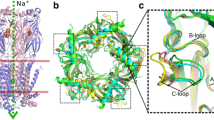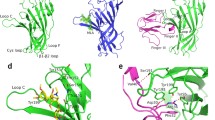Abstract
The binding mode of nicotinic agonists has been thoroughly investigated in the last decades. It is now accepted that the charged amino group is bound by a cation-π interaction to a conserved tryptophan residue, and that the aromatic moiety is projected into a hydrophobic pocket deeply located inside the binding cleft. A hydrogen bond donor/acceptor, maybe a water molecule solvating this receptor subsite, contributes to further stabilize the nicotinic ligands. The position of this water molecule has been established by several X-ray structures of the acetylcholine-binding protein. In this study, we computationally analyzed the role of this water molecule as a putative hydrogen bond donor/acceptor moiety in the agonist binding site of the three most relevant heteromeric (α4β2, α3β4) and homomeric (α7) neuronal nicotinic acetylcholine receptor (nAChR) subtypes. Our theoretical investigation made use of epibatidine 1 and deschloroepibatidine 2 as molecular probes, and was then extended to their analogues 3 and 4, which were subsequently synthesized and tested at the three target receptor subtypes. Although the pharmacological data for the new ligands 3 and 4 indicated a reduction of the affinity at the studied nAChRs with respect to reference agonists, a variation of the selectivity profile was clearly evidenced.







Similar content being viewed by others
References
Dajas-Bailador F, Wonnacott S (2004) Nicotinic acetylcholine receptors and the regulation of neuronal signaling. Trends Pharmacol Sci 25:317–324
Fenster CP, Rains MF, Noerager B, Quick MW, Lester RAJ (1997) Influence of subunit composition on desensitization of nicotinic receptors at low concentrations of nicotine. J Neurosci 17:5747–5759
Nai Q, McIntosh JM, Margotta JF (2003) Relating neuronal nicotinic acetylcholine receptor subtypes defined by subunit composition and channel function. Mol Pharmacol 63:311–324
Gotti C, Clementi F (2004) Neuronal nicotinic receptors: from structure to pathology. Prog Neurobiol 74:363–396
Jensen AA, Frølund B, Liljefors T, Krogsgaard-Larsen P (2005) Neuronal nicotinic acetylcholine receptors: structural revelations, target identifications, and therapeutic inspirations. J Med Chem 48:4705–4745
Lindström J (1997) Nicotinic acetylcholine receptors in health and desease. Mol Neurobiol 15:193–222
Paterson D, Nordberg A (2000) Neuronal nicotinic receptors in the human brain. Prog Neurobiol 61:75–111
Lloyd GK, Williams M (2000) Neuronal nicotinic acetylcholine receptors as novel drug targets. J Pharmacol Exp Ther 292:461–467
Hansen SB, Sulzenbacher G, Huxford T, Marchot P, Taylor P, Bourne Y (2005) Structures of Aplysia AChBP complexes with nicotinic agonists and antagonists reveal distinctive binding interfaces and conformations. EMBO J 24:3635–3646
Celie PH, van Rossum-Fikkert SE, van Dijk WJ, Brejc K, Smit AB, Sixma TK (2004) Nicotine and carbamylcholine binding to nicotinic acetylcholine receptors as studied in AChBP crystal structures. Neuron 41:907–914
Billen B, Spurny R, Brams M, van Elk R, Valera-Kummer S, Yakel JL, Voets T, Bertrand D, Smit AB, Ulens C (2012) Molecular actions of smoking cessation drugs at α4β2 nicotinic receptors defined in crystal structures of a homologous binding protein. Proc Natl Acad Sci USA 109:9173–9178
Le Novère N, Grutter T, Changeux JP (2002) Models of the extracellular domain of the nicotinic receptors and of agonist- and Ca2 + -binding sites. Proc Natl Acad Sci USA 99:3210–3215
Schapira M, Abagyan R, Totrov M (2002) Structural model of nicotinic acetylcholine receptor isotypes bound to acetylcholine and nicotine. BMC Struct Biol 2:1
Mazzo F, Pistillo F, Grazioso G, Clementi F, Borgese N, Gotti C (2013) Nicotine-modulated subunit stoichiometry affects stability and trafficking of α3β4 nicotinic receptor. J Neurosci 33:12316–12328
Wang HL, Gao F, Bren N, Sine SM (2003) Curariform antagonists bind in different orientations to the nicotinic receptor ligand binding domain. J Biol Chem 278:32284–32291
Amiri S, Sansom MSP, Biggin PC (2007) Molecular dynamics studies of AChBP with nicotine and carbamylcholine: the role of water in the binding pocket. Protein Eng Des Sel 20:353–359
Blum AP, Lester HA, Dougherty DA (2010) Nicotinic pharmacophore: the pyridine N of nicotine and carbonyl of acetylcholine hydrogen bond across a subunit interface to a backbone NH. Proc Natl Acad Sci USA 107:13206–13211
Blum AP, Van Arnam EB, German LA, Lester HA, Dougherty DA (2013) Binding interactions with the complementary subunit of nicotinic receptors. J Biol Chem 288:6991–6997
Avalos M, Parker MJ, Maddox FN, Carrol FI, Luetje CW (2002) Effects of pyridine ring substitutions on affinity, efficacy, and subtype selectivity of neuronal nicotinic receptor agonist epibatidine. J Pharm Exp Ther 302:1246–1252
Huang X, Zheng F, Crooks PA, Dwoskin LP, Zhan C (2005) Modeling multiple species of nicotine deschloroepibatidine interacting with α4β2 nicotinic acetylcholine receptor: from microscopic to phenomenological binding affinity. J Am Chem Soc 127:14401–14414
Abin-Carriquiry JA, Zunini MP, Cassels BK, Wonnacott S, Dajas F (2010) In silico characterization of cytisinoids docked into an acetylcholine binding protein. Bioorg Med Chem Lett 20:3683–3687
Grazioso G, Pomè DY, Matera C, Frigerio F, Pucci L, Gotti C, Dallanoce C, De Amici M (2009) Design of novel alpha7-subtype-preferring nicotinic acetylcholine receptor agonists: application of docking and MM-PBSA computational approaches, synthetic and pharmacological studies. Bioorg Med Chem Lett 19:6353–6357
Grazioso G, Cavalli A, De Amici M, Recanatini M, De Micheli C (2008) Alpha7 nicotinic acetylcholine receptor agonists: prediction of their binding affinity through a molecular mechanics Poisson-Boltzmann surface area approach. J Comp Chem 29:2593–2602
Carroll FI (2004) Epibatidine structure–activity relationships. Bioorg Med Chem Lett 14:1889–1896
Linnel RH (1960) Dissociation constants of 2-substituted pyridines. J Org Chem 25:290
Nalam MN, Peeters A, Jonckers TH, Dierynck I, Schiffer CA (2007) Crystal structure of lysine sulfonamide inhibitor reveals the displacement of the conserved flap water molecule in human immunodeficiency virus type 1 protease. J Virol 81:9512–9518
Carroll FI, Liang F, Navarro HA, Brieaddy LE, Abraham P, Damaj MI, Martin BR (2001) Synthesis, nicotinic acetylcholine receptor binding, and antinociceptive properties of 2-exo-2-(2′-substituted 5′-pyridinyl)-7-azabicyclo[2.2.1]heptanes. Epibatidine analogues. J Med Chem 44:2229–2237
Carroll FI, Ma W, Yokota Y, Lee JR, Brieaddy LE, Navarro HA, Damaj MI, Martin BR (2005) Synthesis, nicotinic acetylcholine receptor binding, and antinociceptive properties of 3′-substituted deschloroepibatidine analogues. novel nicotinic antagonists. J Med Chem 48:1221–1228
Kasyan A, Wagner C, Maier ME (1998) Regiochemistry of the reductive heck coupling of 2-azabicyclo[2.2.1]hept-5-ene. Synthesis of epibatidine analogues. Tetrahedron 54:8047–8054
Munson PJ, Rodbard D (1980) Ligand: a versatile computerized approach for characterization of ligand-binding systems. Anal Biochem 107:220–239
Frisch MJ, Trucks GW, Schlegel HB, Scuseria GE, Robb MA, Cheeseman JR, Scalmani G, Barone V, Mennucci B, Petersson GA, Nakatsuji H, Caricato M, Li X, Hratchian HP, Izmaylov AF, Bloino J, Zheng G, Sonnenberg JL, Hada M, Ehara M, Toyota K, Fukuda R, Hasegawa J, Ishida M, Nakajima T, Honda Y, Kitao O, Nakai H, Vreven T, Montgomery JJA, Peralta JE, Ogliaro F, Bearpark M, Heyd JJ, Brothers E, Kudin KN, Staroverov VN, Kobayashi R, Normand J, Raghavachari K, Rendell A, Burant JC, Iyengar SS, Tomasi J, Cossi M, Rega N, Millam NJ, Klene M, Knox JE, Cross JB, Bakken V, Adamo C, Jaramillo J, Gomperts R, Stratmann RE, Yazyev O, Austin AJ, Cammi R, Pomelli C, Ochterski JW, Martin RL, Morokuma K, Zakrzewski VG, Voth GA, Salvador P, Dannenberg JJ, Dapprich S, Daniels AD, Farkas Ö, Foresman JB, Ortiz JV, Cioslowski J, Fox DJ (2009) Gaussian 09, revision A.02. Gaussian, Inc., Wallingford, CT
Liu YP (2001) Applications of effective core potentials and density functional theory to the spin states of iron porphyrin. J Chem Inf Comput Sci 41:22–29
Gold v. 5.1. Cambridge Crystallographic Data Centre, Cambridge, UK
Korb O, Stutzle T, Exner TE (2009) Empirical scoring functions for advanced protein-ligand docking with PLANTS. J Chem Inf Model 49:84–96
Case DA, Darden TA, Cheatham TEIII, Simmerling CL, Wang J, Duke RE, Luo R, Walker C, Zhang W, Merz KM, Roberts B, Hayik S, Roitberg A, Seabra G, Swails J, Goetz AW, Kolossváry I, Wong KF, Paesani F, Vanicek J, Wolf RM, Liu J, Wu X, Brozell SR, Steinbrecher T, Gohlke H, Cai Q, Ye X, Wang J, Hsieh MJ, Cui G, Roe DR, Mathews DH, Seetin MG, Salomon-Ferrer R, Sagui C, Babin V, Luchko T, Gusarov S, Kovalenko A, Kollman PA (2012) AMBER 12. University of California, San Francisco
Wang J, Wolf RM, Caldwell JW, Kollman PA, Case DA (2004) Development and testing of a general amber force field. J Comput Chem 25:1157–1174
Jorgensen WL, Chandrasekhar J, Madura JD, Impey RW, Klein LM (1983) Comparison of simple potential functions for simulating liquid water. J Chem Phys 79:926–936
Carbonelle E, Sparatore F, Canu-Boido C, Salvagno C, Baldani-Guerra B, Terstappen G, Zwart R, Vijverberg H, Clementi F, Gotti C (2003) Eur J Pharmacol 471:85–96
Cheng Y, Prusoff WH (1973) Relationship between the inhibition constant (K1) and the concentration of inhibitor which causes 50 per cent inhibition (I50) of an enzymatic reaction. Biochem Pharmacol 22:3099–3108
Fucile S, Renzi M, Lax P, Eusebi F (2003) Cell Calcium 34:205–209
Parker MJ, Beck A, Luetje CW (1998) Neuronal nicotinic receptor beta2 and beta4 subunits confer large differences in agonist binding affinity. Mol Pharmacol 54:1132–1139
Sullivan JP, Donnelly-Roberts D, Briggs CA, Anderson DJ, Gopalakrishnan M, Piattoni-Kaplan M, Campbell JE, McKenna DG, Molinari E, Hettinger AM, Garvey DS, Wasicak JT, Holladay MW, Williams M, Arneric SP (1996) A-85380 [3-(2(S)-azetidinylmethoxy) pyridine]: in vitro pharmacological properties of a novel, high affinity alpha 4 beta 2 nicotinic acetylcholine receptor ligand. Neuropharmacology 35:725–734
Acknowledgments
This research was supported by the Italian MIUR (PRIN 2009-R7WCZS), the CNR Research Project on Aging, the Regione Lombardia Project NUTEC ID 30263049 and the Fondazione Giancarla Vollaro, Milano. We acknowledge the CINECA and the Regione Lombardia award under the LISA initiative, for the availability of high performance computing resources and support. Carlo Matera wishes to thank “Dote Ricerca”: FSE, Regione Lombardia, which co-financed his postdoctoral position.
Author information
Authors and Affiliations
Corresponding author
Electronic supplementary material
Below is the link to the electronic supplementary material.
Rights and permissions
About this article
Cite this article
Dallanoce, C., Grazioso, G., Pomè, D.Y. et al. Investigating the hydrogen-bond acceptor site of the nicotinic pharmacophore model: a computational and experimental study using epibatidine-related molecular probes. J Comput Aided Mol Des 27, 975–987 (2013). https://doi.org/10.1007/s10822-013-9694-y
Received:
Accepted:
Published:
Issue Date:
DOI: https://doi.org/10.1007/s10822-013-9694-y




